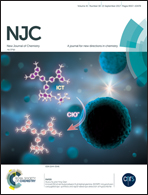Capacitive performance of ruthenium-coordinated polypyrrole
Abstract
Ruthenium coordinated polypyrrole electrodeposited on a carbon paper substrate is developed as an active electrode material for supercapacitors. PPy–Ru(12) was formed by electrochemical polymerization of the ruthenium chloride coordinated pyrrole monomer with a saturation coordination time of 12 h. The capacitance of PPy declined from 249 at 1.0 A g−1 to 102 F g−1 at 20.0 A g−1 with a capacitance retention of 40.9%. The capacitance of PPy–Ru(12) declined from 618 at 1.0 A g−1 to 301 F g−1 at 20.0 A g−1 with a capacitance retention of 48.7%, presenting higher rate capability. The coordination process could induce bipolarons to improve the electrochemical conductivity and rate capability. The capacity retention ratio highly increased from 79.4% for PPy to 91.4% for PPy–Ru(12) after 2000 cycles at 20.0 A g−1, presenting the superior cycling stability of PPy–Ru(12). The coordination reaction between the pyrrole monomer and RuCl3 led to the formation of a tetrahedral structure that restrained volume swelling or shrinking of PPy during the charge–discharge process, accordingly causing improved electrochemical cycling stability. In addition, the all-solid-state PPy–Ru(12) supercapacitor showed a capacitance of 122 F g−1 at 2.0 A g−1 and a capacity retention ratio of 82.8% after 500 cycles. This PPy–Ru(12) with good capacitive performance and electrochemical stability presents promising application as a supercapacitor electrode material.



 Please wait while we load your content...
Please wait while we load your content...